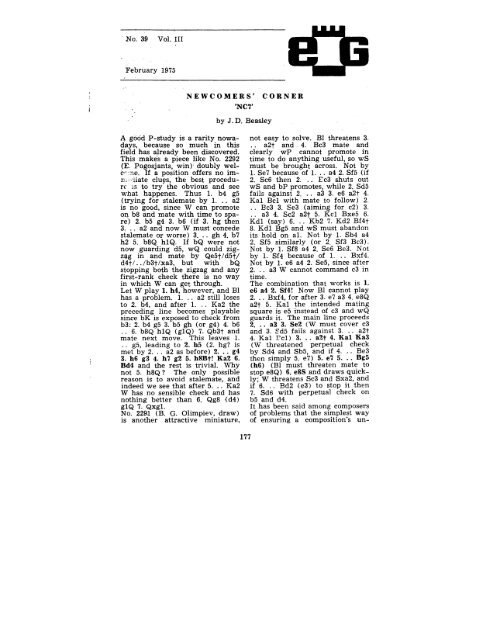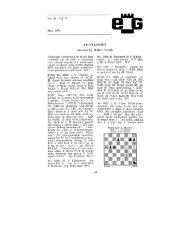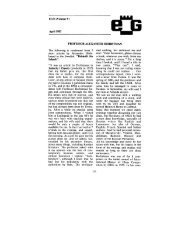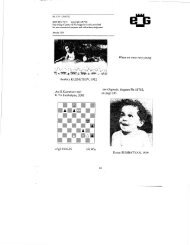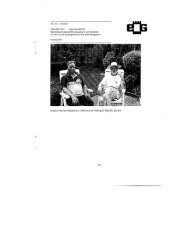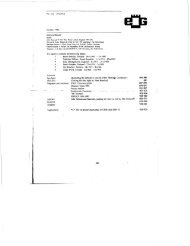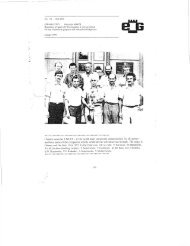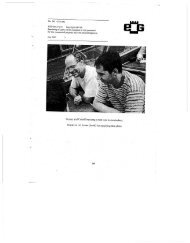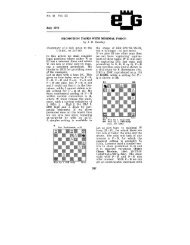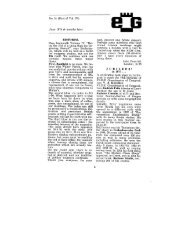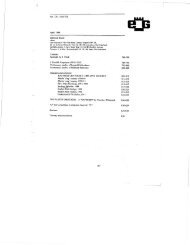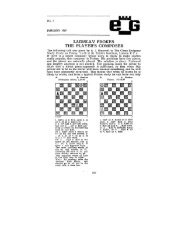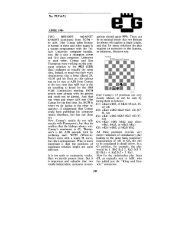You also want an ePaper? Increase the reach of your titles
YUMPU automatically turns print PDFs into web optimized ePapers that Google loves.
No. 39Vol. Ill^February 1975NEWCOMERS' CORNER'-NC7'by J. D. BeasleyA good P-study is a rarity nowadays,because so much in thisfield has already been discovered.This makes a piece like No. 2292(E. Pogosjants, win) doubly welcntne.If a position offers no im-D;~ iiate clues, the best procedureis to try the obvious and seewhat happenes. Thus 1. b4 g5(trying for stalemate by 1. .. a2is no good, since W can promoteon b8 and mate with time to spare)2. b5 g4 3. b6 (if 3. hg then3. .. a2 and now W must concedestalemate or v/orse) 3. .. gh 4. b7h2 5. b8Q hlQ. If bQ were notnow guarding d5, wQ could zigzagin and mate by Qe5f/d5t/d4f/../b3t/xa3, but with bQstopping both the zigzag and anyfirst-rank check there is no wayin which W can get through.Let W play 1. h4, however, and Blhas a problem. 1. .. a2 still losesto 2. b4, and after 1. .. Ka2 thepreceding line becomes playablesince bK is exposed to check fromb3: 2. b4 g5 3. b5 gh (or g4) 4. b6. . 6. b8Q hlQ (glQ) 7. Qb3f andmate next move. This leaves 1.. . g5, leading to 2. h5 (2. hg? ismet by 2. . . a2 as before) 2. .. g43. h6 g3 4. h7 g2 5. h8Bf! Ka2 6.Bd4 and the rest is trivial. Whynot 5. h8Q ? The only possiblereason is to avoid stalemate, andindeed we see that after 5. .. Ka2W has no sensible check and hasnothing better than 6. Qg8 (d4)glQ 7. Qxgl.No. 2291 (B. G. Olimpiev, draw)is another attractive miniature,not easy to solve. Bl threatens 3... a2f and 4. Bc3 mate andclearly wP cannot promote intime to do anything useful, so wSmust be brought across. Not by1. Se7 because of 1. .. a4 2. Sf5 (if2. Sc6 then 2. .. Ec3 shuts outwS and bP promotes, while 2. Sd5fails against 2. .. a3 3. e6 a2f 4.Kal Bel with mate to follow) 2... Bc3 3. Se3 (aiming for c2) 3... a3 4. Sc2 a2f 5. Kcl Bxe5 6.Kdl (say) 6. .. Kb2 7. Kd2 Bf4f8. Kdl Bg5 and wS must abandonits hold on al. Not by 1. Sb4 a42. Sf5 similarly (or 2. Sf3 Bc3).Not by 1. Sf8 a4 2. Se6 Be3. Notby 1. Sf4 because of 1. .. Bxf4.Not by 1. e6 a4 2. Se5, since after2. .. a3 W cannot command c3 intime.The combination that works is 1.e6 a4 2. Sf4! Now Bl cannot play2. .. Bxf4, for after 3. e7 a3 4. e8Qa2f 5. Kal the intended matingsquare is e5 instead of c3 and wQguards it. The main line proceeds2. .. a3 3. Se2 (W must cover c3and 3. Sd5 fails against 3. . . a2t4. Kal Fcl) 3. . . a2f 4. Kal Ka3(W threatened perpetual checkby Sd4 and Sb5, and if 4. .. Be3then simply 5. e7) 5. el 5. .. Bg5(h6) (Bl must threaten mate tostop e8Q) 6. e8S and draws quickly;W threatens Sc3 and Sxa2, andif 6. . . Bd2 (e3) to stop it then7, Sd6 with perpetual check onb5 and d4.It has been said among composersof problems that the simplest wayof ensuring a composition's un-177
soundness is to dedicate it tosomebody, I sometimes feel thatselecting a piece for NC comes agood second. My original choicefor the next study broke when Iwas analysing it, and the alternativewas badly anticipated, soI thought I would save furtherthought by using one of the anticipationsinstead. It was all typedup ready for printing when WVbust it to shreds.So I have fallen back on an oldmaxim: when in doubt, quote alightweight. If you do not knowNC7.1 (F. Sackmann) then youshould. It is a twin study, W toplay and win in both parts. (Solutionat end of article.)NC7.1 F. Sackmann, 1913Win 4+2I: DiagramII: Interchange wK and wSRather longer in the unravellingthan any of the above is No. 2283(J. Fritz, draw). This is a piecewhere any gain of material willbe crucial, for R + P vsBisa winunless the weaker side can proveotherwise (so Bl to play couldclaim a win after as mild a moveas 1. .. a5). while R vs B or S ismerely a draw unless the strongerside can prove a win. Thus Wthreatens to draw by Bxa6,though he cannot play this immediatelyon account of 1. .. Rf5f2. Sf4 Rf6 3. B.. Sh5 and Bl wins.So 1. Se3 (attacking bR and sogiving no time for 1. .. a5) 1.Ra5 (stopping Bxa6, so Bl hopes- the advantage of .. Ra5 over.. Rd6 will appear after a coupleof moves) 2. Sg4f Kgl (to meetKxg3 with .. Kxfl) 3. Bxa6! andW has drawn first blood.Now the onus is on Bl to pick upmaterial, and he must somehowget bS to safety; with bR on d6 hewould have no useful move at thisstage. So 3. .. Ra3f 4. Kf4 (if Wloses touch with bS then .. Rxa6will win 4. .. Sh5f 5. Kg5 Ra5fand again where is wK to go? If6. Kg6 then 6. .. Sf4f and 7. ..Rxa6. If 6. Kh6 then again 6. ..Sf4 (threatening .. Rh5f and.. Rg5f), and if 7. Bc8 defendingwS then 7. .. Rh5f 8. Kg7 Rc5 9.Bd7 (wB must keep guard on wSto avert .. Rg5f) 9. .. Rc7 10.Sf6(e5) Sd5(d3) 11. SxS RxBfand 12. .. RxS. So it must be 6.Kh4 Sf4, and now if wB flees tosafety the near-mate by 7. ..Sg6f 8. Kg3 Ra3f forces wS tosacrifice itself (except after 7.Bb7, when 7. .. Sg6f 8. Kg3 Ra3f9. Bf3 Rb3 10. Sf2 Se5 11. Sh3fKfl 12. Sg5 Sxf3 13. Sxf3 Ke2 isgood enough). So we must try7. Kg3 and 7. •. Sg6 renews thethreat (7. .. Sh5f being of no useto Bl because of the repetitionby 8. Kh4). W's only answer tothese threats of .. Rxa6 and ..Ra3f is 8. Bd3 and after 8. .. Ra39. Sf2 Se5 it looks as if W is helpless;but the tightrope has led toa perpetual check by 10. Sh3f Khl11. Sf2f. A long and (to me) enjoyablestruggle, with every manmoving except bPa6.Solution to NC7.1: 1. g7f Kxh72. gfB. II: 1. Sf7f Rxf7 2. gf Kxh73. f8R.On 3.i.75 Richard Harman gave afully illustrated talk to The ChessEndgame Study Circle, based onthe Novotny and Plachutta studies(numbering nearly 120) in hiscollection. We hope to print thewhole talk as a Rueb Supplementin EG40 with the cooperation ofthe Rueb Foundation- AJR178
SPOTLIGHTby Walter VeitchEG36, p. 81: NC 4.2. This studyreminds me of this game positionwhich I came across a few yearsago. Play was brief: 1. .. Kc3 2.Kf4 Kb2 and the Tunisian masterresigned. The comments statedthat 1. .. Kxc4 would not win as2. Kf4 Kc3 3. Ke4 draws. Possibilitieshere are 3. .. a4 4. Kd5 c45. a3 =, or 4. .. a3 5. Kxc5 Kb2 6.c4 Kxa2 7. Kd6 = . NeverthelessBl in fact wins comfortably by1. .. Kxc4 but after 2. Kf4(3) not2. .. Kc3 but either 2. .. a4 or 2... Kd4 and the rest is easy.Belkadi v. PachmanChess Olympiad, 1958The comment to this studyprompts one to ask why Rinckhad no bPf7. The answer appearsto be that after 5. .. f5 6.Be5 Qgl (instead of .. f4) draws,the previously set win of 7. Qb5fKa7 8. Bc5f no longer being available.No. 2036 is marked 4 + 5. Shouldbe 4+6.No. 2055: E. Pogosjants. Blackwins, must do, with piece andposition up. E.g.- 1. .. Sf3f 2.Kh3 Ke2 3. Kg3 Sf2 4. Kf4 Sxd2.Now if 5. g5 Sh3f 6. Kg4 Sxg5 7.Kxg5 Kdl 8. Ba3 Kc7 wins, andif 5. Kfo Sb3 6. Bf4 Kf3 againwins easily.F. Lazard, 1911Black to Play 4+3All this is hardly remarkable,Pachman merely chose a differentwin. But did he? W in factresigned in a drawn position! Forafter 1. .. Kc3 2. Kf4 Kb2 3. Ke4Kxa2 4. Kd5 a4 5. Kxc5 a3 6. Kd6Kb2 7. c5 a2 8. c6 alQ 9. c7 Qa6f10. Kd7 Qb5f 11. Kd8 Qd5f 12. Ke8Qc6f 13. Kd8 Qd6f 14. Kc8 Ka3"Avoiding, of course, BFs stalematepossibilities", say the notes,but 15. c4 Kb4 16. Kb7! (not 16.c5 as suggested) and Wh draws ashe can never again be forced toc8, a version of the NC 4.2 position.An example of two Homersnodding!No. 2028: V. N. Dolgov. No win.Win 4+21. Sf4f Kh6 2. Se6 Re8 3. g8Q Rxg8 4.Sf8 Rg5 5. Sg6H wins, but not 5. e8Q?Re5f 6. Qxe5 stalemate.Nos. 2059 & 2062: M. Sh. Gorbman.In the former position Bldraws easily by 3. . . Ra2. In thelatter a third win is 5. Sb7 Re8 6.Sd6. Not good enough. Moreoverthe idea of No. 2062 has alreadybeen shown to perfection in thisclassic study by F. Lazard.No. 2084: N. Kralin. Instead ofcommitting ceremonial suicide,Black can win simply by 1.179
Rb8 (If 2. g7 Bh6, or if 2. Bd5Bd4). The win .. Rb8 is availabletill move 6. Black can alsowin by 1. . . Bc5 or draw by 4. ..Rxe4 5. h8Q Bxg5, Most of this iseliminated if wB is moved to d5,but 1. .'. Rb8 2. Bg8 Bc5 is stilltoo strong.No. 2091: P. Joita. Bl wins by 2... Rxh7 3. Bxa8 Kc2!, threateningmate, 4. Ka4 Kxd3 5. Bhl Kc4 6.Ka5(3) Re7 and bPh2 soon costsa bishop.A SOURCE IDENTIFIEDDavid Hooper, researching at theBritish Museum (Colindale)Newspaper Library for the bookTHE UNKNOWN CAPABLANCA(to be published by Batsford)which he is writing in collaborationwith Dale Brandreth (USA),stumbled on the attached diagram.It, and the full text which I havetranslated, appeared in the "fifthsupplement" to the Berlin newspaperVOSSISCHE ZEITUNG, onSunday, 26th July 1914, in the regularchess column edited by Dr.Emanuel Lasker.Endgame, composed byLasker and Capablanca"Endspiel, komponiert vonLasker und Capablanca"White moves and wins 4-f-4"The above endgame owes itsexistence to an accident. A weekago the Cuban master camethrough Berlin. I was about totravel to Mannheim for the Congressof the German Chess Federation,where the question of thefounding of an international chessfederation was to be discussed,and this matter was also of interestto Capablanca. We thereforearranged to meet each other. Wedid meet, and we were able toconfirm that our points of viewagreed in important respects. Inthe meantime our encounter in theCafe Kerkau had attracted attentionand a chess enthusiast tookthe opportunity to offer a prizefor ten quick games ("Schnellpartien")between us. A conditionwas to be that no move wasto take longer than five seconds.Despite this speedy pace weplayed quite passable games, Capablancain particular committinghardly any errors even under thisconstraint ("Insbesondere bezeichnetesich Capablancas Spielauch bei dieser Fixigkeit nochdurch Mangel an Fehlern aus"),while I was the one to go astraymore often. The result was Z.6V2, L. 3V2. In one of the gan. sC. had won very prettily. Tneidea that C. had hatched on thisoccasion was afterwards a littlestylised ("ein wenig stilisiert") byus both, and in this way the aboveendgame was created.The piece is almost nothing butthought ("fast ganz und gar Gedanke").If you hit upon the basicidea, the solution is easy,otherwise it appears to be quiteinsoluble. It goes 1. Sxc7 Sxc7 2.Ra8f (and not Kxc7, which givesstalemate) 2. .. Sxa8 3. Kc8 andwins along well-known lines".A photocopy of the column is infront of me as I type.It is worth noting that this was180
the last column to appear beforethe outbreak of World War I(hence the "accident" was extremelyfortunate indeed), that nogames have survived, .. and thatthe Newspaper Library is lessthan ten minutes walk fromwhere I live - and still I did notget the story right in TEST TUBECHESS, position 204! AJR.IN MEMORIAM F. J. PROKOP (18.vii.1901 to 21.ix.1973)Cne of the last remaining Mohicansof the once dominant, internationallyesteemed Czech schoolof chess composition has passedaway.Prokop was born in the thoroughlyCzech countryside of Horovice,into an obediently loyal Czecho-Austrian family who christenedh?m Franti^ek Josef, in honor ofi :iir Austrian emperor FrancisJoseph. Eut they also endowedtheir son with additional "disciplines"in educational fields andmultilingual Prokop studied atPrague's Technical College, addedNatural Science and Law at PragueUniversity, and ended up injournalism as his profession. Hiscomplex background was to casta long shadow.In 1923, at the age of 22 and alreadya strong player, Prokopstarted in "28.rijen" a chess columndedicated to endgame studies,one of several to follow inother newspapers under his editorship.With astonishing speedProkop rose to become an outstandingcomposer of studies combiningstrict economical simplicitywith great depth of content. Withunfailing perseverance he successfullytackled difficult tasksbut in 1931 suprisingly switchedover to problemdom, specializingin selfmates which he masteredwith virtuosity.Although somewhat finicky in hislikes and dislikes, Prokop displayedimpeccable knowledge andobjectivity and an attractive prosewhen it came to literary production.In his historical and bibliographicaltreatise "Ceskoslovenskov svetovem §achu" (Czechoslovakia'srole in InternationalChess), Prague 1935, 321 pages,he renders a brief and accurateself-portrait (p. 96):"... In output, within a short period,Prokop even surpassed thestature of contemporary Czechcomposers; moreover, he createda novel and personal style, speciallyin his stalemate studies.Inspired by /Zdenek/ Mach, hecomposed studies with stalematethemes in such a fashion that thefinal combinations included several,always economical, stalematevariations."In a qualifying footnote, Prokopcontinues; "It so happened thatduring a discussion at the CzechChess Society, between M. Havel,L. Knotek and F. J. Prokop aboutendgame studies, the problemistDr. Mach suddenly produced onthe empty board something of astalemate net. As was Mach's habit,he nonchalantly and in aquizzical manner posed the doubtingquestion if a theme as sketchedout by him, could ever beworked out in a study showingtwo variations, on white and blacksquares alternatively. The participantsagreed that it would indeedbe extremely difficult oreven impossible. But Prokop wasintrigued and a week later presentedthe Society with his firstecho stalemate study. It wasawarded 3rd-4th prize ex aequo(together with one by his compatriotO. Duras) in "ShakhmatnyListok" 1925" (see A).181
L. F. J. Prokop=3-4th Prize,Shakhmatny Listok, 1925Draw 3-f51. Bh4/i Bxh4 2. Rxg4, with two Unes:2. . . Bf2 3. Rxg2 62 4. Rg5 dlQ 5. Rd5f.2. . . Bfl 3. Rxh4 d2| 4. Ka5 dlQ 5. Rd4f.i) 1. Rg8f? Ke7 2. Bel Bf3 3. Ka5 Kf74. Rb8 Bg5 5. Rb2 Bf4 6. Kb4 Be2 7. Kb3g3 8. Rbl g2 9. Bf2 Bd2 10. Kc2 Ke6wins.Subsequently Prokop concentratedmostly on selfmates and in1940 published a collection of his100 best problems in this field,excelling the hitherto leadingCzech composer Knotek in ideasand precision of construction.For a "minority" citizen to havea book published in Czech landsunder German rule was somewhatan exception, but in 1943 Prokopeven followed up with an enlargededition of his studies: "212Endspielstudien", published inGerman.By environment and by chess tradition,Prokop was native to thecore but politically a right-wingerand educationally versatile. Heseemed to adjust well and unobtrusivelyto the powers that be,and as the editor of one of the indigenousCzech-language paperspermitted to appear during theWar, Prokop made no waves (sic).His book of studies contains onediagram prominently dedicatedto the German Chess Czar E. Postof Berlin.No wonder that after the liberationProkop was under a cloud, ina country freed from domination,and with a new social alignment.J. Fritz' book on the endgamestudy (published in 1951) lists allprominent Czech study composersand pointedly omits the "nonperson"Prokop. Perhaps as a futureblessing, Prokop thus waspolitically neutralized. But withchess still a sideline in human affairs,he was subsequently permittedto function as the chessinstructor in Prague's Central Institutefor Youth and to continueputting his phenomenal chess versatilityand eruditon to productiveuse. In 1968, in the aftermath ofthe political thaw, the Institutepublished Prokop's "Kouzlo SachovehoDiagramu - Zauber desSchachdiagramms", a bilingualcollection with explanations andB. F. J. Prokop3rd Prize, International'Fizkultura' Tourney,Moscow 1925(Diagram 26 in FJP'sZauber )Draw 44-5"Perpetual stalemate. Thus the studywas defined in the USSR, but it is appropriateto call it a treadmill. Tryingto destroy the stalemate net, Bl keepschecking in a rhythmical circle whereaswK keeps abreast in the same direction.The study is cited in almost all Sovietbreviaries as a shining example of beautyin chess" (Prokop).1. Sf8t Kh8 2. Sg6t Qxg6 (Kh7? f8Smate) 3. f8Qt Kh7 4. Bbl Bc3f/i 5. Ke3Bd4f 6. Kd2/ii Be3f/iii 7. Kc3 Bd2| 8.Kd4, or 7. .. Bd4f 8. Kd2, draw,i) 4. .. Qxbl 5. Qf5f Qxf5 stalemate. If4. .. Be3f 5. Kc3. At any point fromnow on bB can check wK on two squares,but the same stalemate positionsarise in either case, in the end.ii) Whenever WK takes bB. .. Qxblwould win.iii) 6. .. Qxbl 7. Qh8t Kg6 8. Qh7f (ina rare error Prokop gives 7. Qxg7|, but7. .. Bxg7 wins).182
prefaces in Czech and German, of59 studies and, in juxtaposition,59 selfmates with correspondingthemes. Diagrams No. 26 and 26(a)on page 99 (our B and C) are givenhere as examples. (Prokop'sonly remaining Czech rival, continuingand looking back at compositionof first - class echo studiesand also of selfmates is Dr. J.Fritz - somewhat younger thanProkop but also in his early 60s).On page 13 of his book, Prokopcredits the British with inventingthe selfmate about 500 years agoand describes it as typical of dryEnglish humor; that the weakerparty is to prevail over the strongerone, but is a reluctant Davidwho has to be compelled to do so.For Prokop, the selfmate isFtraight orthodox humor incarnateand he refuses to rank itamong Fairy Chess, claiming thatthe basic ingredients are no differentfrom those in orthodox treatmentof problems and Prokop'sC. F. J. Prokop1968Diagram 26a inFJP's Zauber desSchachdiagrammsSelfmate in 5(W moves first)8+4"A diagonal battery. wB assumes themain role in preparing a fatal blow administeredby Bl's double check" {Prokop).1. Bd4, with two lines:1. .. c6 2. Bc5 cb 3. Be3 b4 4. Bd2 b3 5.Qf2f Sxf2 double check and mate.1. .. c5 2. Bf6 c4 3. Re3 c3 4. Sf3f (double!)4. . . Kh3 5. Self Sxe3 doublecheck and mate.Fascinating compulsion on two differentplateaus.constructions maintain a strongaffinity to practical play, as seenfrom Diagram C.Prokop's over-the-board strengthwas already noteworthy when hestarted to compose, but thereafterhe acquired formidable stature asa practical player. In the thirdKautsky Memorial Tournament,Prague 1926, he placed first, togetherwith master Schulz andInternational Master Dr. SkaliSka.It is worth noting that almost anyof the leading endgame studycomposers who formed the "CzechSchool" were strong practicalplayers imbued with love for theartistic endgame study (or viceversa!), as for instance Dedrle,Louma, Soukup, Traxler, Van6ura,Votruba, Grandmasters Duras,Foltys and Reti, and mastersHasek, Mandler, Moravec, Prokes,Prokop, F. Richter, Schubert, Skalicka,Vecsey - evidence of the affinitybetween these branches ofchess.Prokop was a tall, goodlookingand composed personality, elegantand aloof but otherwise most helpfulwhen asked directly for adviceby a novice (like myself) duringany of his sporadic visits to theDobrusky Chess Club, the meeting place of Prague's chess elite.The last time I met him was inthe summer ob 1968 - he was exuberantover the publication of hislast book and felt encouraged toproceed working on a history ofchess, but retired in 1969 and fadedinto oblivion, briefly interruptedby I. Mikan's appreciationin "Ceskoslovensky Sach" on his70th birthday. He must have beenlonely in his later years as hisdeath in September 1973 becameknown only belatedly and wasnot confirmed in the same periodicaluntil May 1974 when L. Kopacgave Prokop's memory agrand last send-off.WALTER KORNEast Orange, N.J. USA.183
TOURNEY ANNOUNCEMENTSThe 5th Thematic Tourney is announcedby Shakhmaty v SSSR.The theme is the "copycat" manoeuvre,that is, the same reasonfor a move by a W man, and amove by a similar Bl man. Themoves may be either W first orBl first, but they must be in thesame main line. By 30.iv.75, toShakhmaty v SSSR, P.O. Box 10,Moscow G-19, 121019 U.S.S.R.,with "OBYEZYANYA THEME"on envelope. Judge: Al. P. Kuznetsov.(See attached example.)Y. Dorogovand Al. P. KuznetsovShakhmaty v SSSR, x.74Win 9+7The example illustrates "copy-cat"manoeuvres - see Bl's 4th and W's 7thmoves, and Bl's 8th and W's 11th.1. Sf7f Kg8 2. Sh6f Qxh6 3. f7f Kh8 4.Rb8f Qf8 5. Rxf8f Kg7 6. Qxa3 Rdlf 7.Qcl Rxclf 8. Kb2 Ral 9. Kxc2 Rxa2f10. Kb3 Rxa6 11. Rh8 Kxf7 12. Rxh7fwins.The Italian Problemists Associationannounces an internationaltourney in memory of Dr AlbertoNardone, a famous analyst and''cook-hunter". By 31.iii.75. To:Sig. Gino Mentasti, Via Grottin53, 16012 Busalla, ITALY.Judge: R. Ravarini.The Czechoslovak Chess Federationannounces a section for studiesin a formal tourney with theclosing date (receipt) of 9.V.75.Send (2 copies) to Josef VOLF,Na vysinach 6, 460 05 Liberec 5,CZECHOSLOVAKIA.Judge : Miroslav Sindelar. "Valuablebook prizes will be awarded."Incidental items- from Harold C. Schonberg'sGrandmasters of Chess we learnthat Fischer broods over endgamestudies. Can anyone confirmthis? I am not aware thatthe World Champion has evershown a positive interest in studiesbut would be delighted tohave evidence. Fischer does notsubscribe to EG.- from Soviet Weekly, ll.i.75:"The experts believe that morethan 20,000 chess studies andabout 100,000 problems havebeen made public in all countries.Collecting and systematisingthem is a titanic job andhas not been accomplished byanyone so far. Therefore ofgreat interest for chess problemdevotees is the collectionof 30,000 chess compositionsmade by a Moscow factory engineer,Igor Slyusarenko. Onequickly orientates himself nthis mass of problems with -;;ehelp of Slyusarenko's efficientlyprepared filing system." Canone of our Moscow readers enlightenus about the classificationmethod used by Slyusarenkofor studies?ObituaryH. Edson, EG supporter, died inMarch 1974. He frequently attendedthe meetings in WigmoreStreet when his work in the PostOffice permitted.184
DIAGRAMS AND SOLUTIONSNo. 2248 V. S. Kovalenko(No. 82)4 H.M.,New Statesman, 1973Award l.xi.748. Rxc2 e5 9. Rd2f Kc5 10. h5 e4 11.Kg6 e3 12. Rdl. viii) 8. . . Kxd49. Rxa3 e5 10. Kf6 e4 11. Kg5 e312. Kf4 e2 13. Re3 wins."A curious self-block by Bl is forcedto allow W to free his piecesand evaluate the material plus/'No. 2249 V. A. Bron(No. 36)5 H.M.,New Statesman, 1973Award: l.xi.74Win 4+4N- 2248- V. S. Kovalenko. 1. h4Bn3t/i 2. Kg7/ii Ba3/iii 3. Ral Bd64. Bb2 Kc2 5. Bd4 Kd3/iv 6. RblBc2/v 7. Rcl/vi Ba3/vii 8. RalBd6/viii 9. Bb2 wins, as c2 is nowblocked for bK. i) 1. .. Ba3 2.Ral Bb3f 3. Kg7 Kxc3 4. Rxa3 e55. ho Kb2 6. Rxb3f Kxb3 7. h6 e48. h7 e3 9. h8Q. ii) 2. Kf8? e5f 3.Kg7 Ba3 4. Ral Kxc3 5. Rxa3 e46. h5 e3 7. h6 e2 8. Ral Bc2 draw,2. Kh8(h7)? Ba3 3. Ral Kxc3 4.Rxa3 e5 5. h5 e4 6. h6 e3 7. h7 e28. Ral Bc2 9. Rel Kd2 draw, or inthis 5. Ra5 e4 6. Re5 Bc2 7. h5 Kd28. h6 e3 draw, iii) 2. .. Bf4 3. RflKxc3 4. Rxf4 Ec2 5. h5 e5 6. Rf3fKd2 7 h6 Be4 8. Rg2 and 9. Kf6, orin this 6. . . Kd4 7. h6 Be4 8. Rg3Bc2 9. Kf6 Bh7 10. Rg7. iv) Whatis W's continuation now? If 6.Bf2? Be5f. v) 6. .. Kxd4 7. Rxb3e5 8. Rb6 Bc7 9. Rc6 Bb8 10. h5 e411. He6 Be5f 12. Rxe5 Kxe5 13. h6e3 14. h7 e2 15. h8Q elQ 16. Qe8fand 17. Qxel, and if in this 8. ..Kc5 9. Rbl e4 10. h5 e3 11. Kg6Bg3 12. h6 e2 13. h7, while in replyto 11. Kg6 there are three otherpossibilities:- 11. .. Bf8 12. Kf5Kd4 13. Kf4 Kd3 14. Kf3 Bh6 15.Rdlf. 11. .. Kd4 12. Rdlf Ke5 13.h6. 11. .. Kc4 12. Rclf Kb3 13. h6.vi) 7. Rb2? Ba4 8. Ra2 Bb3 9. Rb2Ba4, with positional draw, 10. Rg2Bc6 11. Rg4 Bf3. vii) 7. .. Kxd4185Win 4-f2No. 2249: V. A. Bron. 1. tl Kf6/i2. Bb5/ii Ral/iii 3. Bc4 Rhl 4.Ke8/iv Relf 5. Kd7 Kg7/v 6.Kc6/vi Ral 7. Kb6 Rblf 8. Bb5Ral/vii 9. Be8 Kf8/viii 10. a7Ke7/ix 11. Kb7 Rblf 12. Bb5. Thethird time on this square. 12. ..Rxb5f 13. Ka6 Rbl 14. f8Qf Kxf815. a8Qf. i) 1. .. Rxa6 2. Kg8wins, ii) 2. Bb7? Rh5 3, Kg8 Rg5|4. Kf8 Rh5 5. Ke8 Re5f 6. Kf8 Rh5drawn, iii) 2. . . Rxb5 3. a7 Rh54. Ke8 Re5f 5. Kd7 (Kd8? Kxf7)5. .. Rd5f 6. Kc7 Rc5f 7. Kb7 Rb5f8. Ka6. iv) 4. Kg8? Rglf 5. Kf8Rhl. v) 5. . . Re7t 6. Kd6 wins,vi) 6. Be6? Kf8 7. Kc6 Ral 8. Kb6Rblt 9. Kc7 Ral. 6. a7? Ral 7. Ke8Relf 8. Kd7 Ral. 6. Kc7? Kf8. 6.Kd6? Kf8 and 7. Kc6 after all.vii) 8. .. Kxf7 9. a7 Ral 10 Ba6Rblf 11. Kc5. viii) 9. .. Rblt 10.Ka5 Rait 11. Ba4 Rcl 12. a7 Rc813. Be8 wins, ix) 10. .. Rblt 11.Ka5 wins."Very charming miniature - oneof the best of its kind - with athrice - repeated wB manoeuvre/*
No. 2250 V. Korchnoiv. A. Karpov19th Match Game,Moscow 1974Position after White's54th moveNo. 2250aKorchnoiv. KarpovPosition after 62. Qd2f.Black to Play 3+3No. 2250: V. Korchnoi v. A. Karpov.54. .. f4/i 55. Kb4 Kg2/ii 56.a5 f3 57. a6 12 58. a7 flQ 59. a8Qf/iii Qf3 60. Qa2| Qf2 61. Qd5f Qf362- Qd2f- See No. 2250a.i) Genuinely study-like is 54. . .g2 55. Kb4 Kf2 56. Kc3/iv glQ/v57. Rxgl Kxgl 58. Kd3/vi Kh2 59.a5 14 60. a6 f3 61. Ke3 Kg3 62. a7f2 63. Ke2 Kg2 64. a8Qt, which is,of course, a well known theoreticalconclusion. ii) 55. .. g2 56.Kc3 Kf2 57. Kd4 f3 58, Ke4.iii) The note in 64 reads: Despitethe remoteness of the forces fromeach other Bl does not succeed inrepelling the attack by his opponent'smajor pieces. iv) 56. a5?glQ 57. Rxgl Kxgl 58. a6 f4 59.a7 f3 60. a8Q f2 with a theoreticaldraw, v) 56. .. f4 57. Kd4 f3 58.Ke4 vi) 58. Kd4? Kf2 59. Ke5Ke3 60. Kxf5 Kd4, or in this 59. a5f4 60. a6 f3 61. a7 Kgl 62. a8Q f2.No. 2250a: Korchnoi v. Karpov.This position appears to breakfresh theoretical ground. Thegame concluded- 62. . . Qf2/i 63.Kc3 Kgl/ii 64. Qdlf Kg2 65. Qd3/iii Qc5f/iv 66. Kb3 Qb6f 67. Kc2Qh6f 69. Qe3 Qh4 70. Rb8 Qf6 71.Rb6 Qf5 72. Rb2 Kh2 73. Qh6f Kgl74. Qb6f Kh2 75. Qb8 Kh3 76.Qh8| Kg4 77. Rb4f Kf3 78. QhlfKf2 79. Rb2. Bl resigned,i) There is no comment in 64 butthis surely is wrong. It allows186Black to Play 3+3wK to approach. After 62. .. Khlit is clear neither to David Hoopernor AJR how W can makeprogress. It looks as if Bl shouldnot necessarily aim to advance hisP, which could even have a crampingeffect on his own movements,ii) 63. . . Qxd2f 64. Kxd2Kf2 65. Rf8f wins, iii) An alternativegiven in 64 is 65. Qd5f Kgl/v 66. Re8 Qf6f/vi 67. Re5 g2 68.Qd4f wins, iv) AJR's suggestionof 65. . . Khl, to answer 66. Rxg3with 66. .. Qxg3 67. Qxg3 stalemate,and similar bQ-sacrificelines after 66. Qxg3 Qb2f, is met,David Hooper convincingly suggests,by 66. Rh8f Kg2 67. Rh5with threat of Rf5. v) 65. . .Qf3| 66. Qxf3f Kxf3 67. Kd2 4268. Kei. vi) 66. .. g2 67. QalfQfl 68. Qd4t wins bQ.No. 2251C. M. Bent(No. 62)1 Comm.,New Statesman, 1973Award: 8.xi.74Draw 4+5
No. 2251: C. M. Bent. 1. gSe7f/iKe6/ii 2. Rf6f Kd7 (Kxf6;Sd5f) 3.Sb6f Ke8 4. Sg6. For Rf8f. 4. ..Qa5f 5. Kbl/iii Qelf 6. Ka2 Qa5f7. Kbl Kd8 8. Rc6 Ke8 9. Rf6 Kd810. Rc6 draw.i) 1. Rxhl? Qa4f 2. Kbl Qe4f wins.1. R(K)xal? Sd3 wins, ii) 1. ..Kc5 2. Rf5f and 3. Rf4f draw.1. .. Ke4 2. Rf4f Kxf4 3. Sd5f.iii) 5. Kb3? Qb5 6. Ka2 Kd8 wins."A brilliantly original final position,but a weak introduction, andstatic features, rob this of a prize."No. 2252C. M. Bent2 Comm.,New Statesman, 1973Award: 8.xi.74Draw 4+5No. 2252: C. M. Bent. 1. Sd6f/iKxf8 2. Sxc4 Rclf/ii 3. Kh2 Bf4f4. Kh3 Rxc4 5. Rb8t/iii K-/iv 6.Rb7f Bc7 7. Rb4 Rxb4 stalemate,i) 1. Rxh6? Bd5f 2. Kgl Rg2f 3.Kfl Bc4| 4. Kel Sf3f 5. Kdl Bb3f6. Kcl Rc2f 7. Kbl (Kdl, Rh2f)7. .. Sd2f 8. Kal Ra2 mate. 1.Rf6? as before, until 4. .. Bd2f 5.Kdl Bb3 mate, ii) "The captureof wS must wait/' iii) "bS cannotbe captured with wR on blsquare." iv) 5. . . Bxb8 is stalemate."Drama on the 4th rank. The playthroughout is excellent, but onlya Commend due to anticipation."No. 2253 R. tavariani(No. 63)3 Comm.,New Statesman, 1973Award: 8,xi.74Draw 3+4a) 4. .. Qe7 5, Re4/iii Qc5 (Qxe4;Kxf8) 6. Re5 Qb4 7. Re4 Qd6 8.Re6.b) 4. .. Ba3 5. Ra4 Bc5 6. Rc4 Be77. Rc7. Also, 4. .. Bh6 5. Rc6 draw,i) 1. .. Bxd4 2. f8Q Be3t (elQ;Qd8f, Qc8(c7)f draws) 3. Kg6elQ 4. Qe7| draw.ii) 2. Re4? Kf2 3. Rxc4 (Rf4f,Ke3;) 3. .. Bf8| 4. Kh7 elQ 5. Kg8Be7(-) 6. Rc7 Qglf wins,iii) 5. Rc7? Qd6/iv 6. Rd7 (Rc6,Qb8) 6. .. Qh6 7. Rd3| Kf4 8. RfKe5 wins.iv) 5. .. Qb4? 6. Rb7 Qc5 7. Rc7draws."A positional draw with wR andwP holding bQ and bB. The repeatedR-offer is piquant."No. 2254S. Belokon(No. 60)4 Comm.,New Statesman, 1973Award: 15.xi.74No. 2253: R. Tavariani. 1. Rd4fKg3/i 2. Rxc4/ii Bf8f 3, Kh7 elQ4. Kg8 with 2 positional draws:- -Win187
No. 2254- S. Belokon. 1. Qcl Rf52. Kal Ra5f 3. Ba2 Rg5 4. Kbl Rgl5. h3/i Rg8 6. Qdl Rgl 7. Kcl Rg88. Qel Rgl 9. Kdl Rg8 10. Qfl Rgl11. Kel wins. i) 5. h4? Rxclf 6.Kxcl , . 10. Kg2 Kg4 11. Bbl Kh412. Kf3?? Kh3."A witty shuffle along the firstrank."No. 2255 G. Grzeban(No. 71)5 Comm.,New Statesman, 1973Award: 15.xi.74No. 2256 P. Sadger(No. 46)6 Comm.,New Statesman, 1973Award: 15.xi.74Draw 5+7No. 2255: G. Grzeban. 1. Qel Bd7/i2. Qhl| Re4 3. c4 ii c6/iii 4. Qh8fRe8' 5. Qxe8f Bxe8 6. f3, any, stalemate,i) 1. .. Bh5? 2. Qhlf f33. Qxh5. ii) 3. Qxe4f? c6 and thethreat of .. Bc8 mate wins. 3.Qh8f? Re8 4. Qhlf c6 wins.iii) 3. . . f3 4. Qh8| (Qxf3? c6; andno stalemate) 4. . . Re8 5. Qxe8fBxe8 is stalemate, and also adraw is in this 4. . . Be8 5. Qe5(Qf6 draws, too) 5. . . Rxe5. 3. ..Bc6 4. Qh6 draw. 3. .. Kb8 4.Qblf."A short, but piquant, self-stalemate.'*No. 2256: P. Sadger (Israel). 1.Ke3/i Rbl/ii 2. Kf2 alB/iii 3.Kgl/iv Kel 4. Sf3f Kdl 5. Sh4 Kel6. Sg2f Kdl 7. Sf5 Ke2 8. Sd4f Kdl9. Sxc2 with 4 possibilities: 9. ..Kxc2 10. Se3 mate, 9. .. Sxc2 10.Kfl and 11. Se3 mate. 9. ., bc(dc)10. Kfl and 11. Se3 mate, and 9. ..Ke2 10. Sd4f Kdl 11. Kfl andmates, i) 1. Kf3? Kel and 2. ..dlQ. 1. Sf3? Rbl 2. Ke3 alB 3. cbWin 5+14c3 and .. bSc4. ii) 1. .. Sbl or1. .. Kel 2. Sf3(f). iii) 2. ..alQ(R) 2. Sfl(f5), e.g., mating.2. .. alS 3. cb/v c3 4. Se4 and 5.Sxc3 mate/vi. iv) 3. Sxc2? Kxc2.3. Kg2? Kel 4. Sf3f Kdl 5. Sh4Kel g2 is blocked. 3. cb? c3 (thisworked after 2. .. alS) 4. Se4bSc4 5. Kfl Se3f/vii 6. Kgl Bb27. Sf2f Kel. v) 3. Kgl? (as after2. .. alB) 3. .. Kel as mainline to 9. Sxc2 S(al)xc2 10. KflRal. vi) 4. Sfl? bSc4 5. Sf5 Bb2.4. Se2? de 5. Sxe2 Sd3f 6. KflBb2. vii) 5. .. Bb2 6. Sf2f Kcl7. Sxd3f Kdl 8. Sf2f Kcl 9. Se2mate."Bl's move 2 variations providethe counterpoint, and W's explosive9th the effect, in this 'Pandora'sBox' study."No. 22571st Prize,Szachy, 1973Award: vii.74J. Fritz(xii.73)Win 4+6188
No. 2257: J. Fritz. Judge: J. Rusinek.1. Rd6f/i Sf6/ii 2. Rxf6f Kg7 3.Rg6f Kf8/iii 4. Rg8f Ke7 5. Re8fKd6 6. Re6f Kc7 7. Rc6f Kd7(d8)8. Bf3 Bxf3 9. Rh6 hlQt 10. RxhlBxhl 11. 0-0-0f wins,i) 1. Rxa6f? Sf6 2. Rxf6f Kg7 3.Rd7f Kxf6 4. Rd6f Ke7. ii) 1. ..Kg5 2. Ra5f and 3. Rxh5. iii) 3... Kxg6 4. Bxh5| and 5. Kf2. 3. ..Kh7 4. Bc2 hlQt 5. Rglf.No. 2258 F. S. Bondarenkoand Al. P. Kuznetsov(ix.73)2nd Prize, Szachy, 1973No. 2259 V. N. Dolgov(v.73)3rd Prize. Szachy, 1973Win 3-f4No. 2260 E. Dobrescu(vii.73)1 Hon. Men.,Szachy, 1973Win 8+9No. 2258: F. S. Bondarenko andAl. P. Kuznetsov. 1. Sf3f gf 2.0-0-0 Kg4 3. Rhl Kh3 4. Kdl Kg25. Kel Kxhl 6. Kfl d5 (Sd5;Bxa4)7. Ba6 Sa8 8. Bc8 Sb6 9. Bb7 h5 10.Ba6 Sa8 11. Bc8 Sb6 12. Bb7 h4 13.Ba6 Sa8 14. Bc8 Sb6 15. Bb7 h3 16.Ba6 Sa8/i 17. Bc8 Sb6 13. Bb7.i) 16. .. d6 17. Bb7 Sd7 18. Bxd5Se5 19. Be4.JRH- Earliest of these duels isWeenink (1924), p. 51 of Rueb'sStudien III.No. 2259: V. N. Dolgov. 1. Re6fKd7/i 2. Rd6t Kc7 3. Rc6f Kb7 4.Rb6t Kc7 (Ka7;Ra6f) 5. hRc6fKd7 6. Rd6f Ke7 7. Re6f Kf7 8.Rf6f Ke7/ii 9. bRe6f Kd7 10. Rd6fKc7 11. Rc6f Kd7 12. Rf7f Ke8 13.Rg7 wins.i) 1. .. Kf7 2. hRf6f Kg7 3. Rg6fKf7 4. eRf6f Ke7 5. Rf2. ii) 8. ..Kg7 9. Rg6f Kf7 10. Rxg2.Black to Move, 3+4White winsNo. 2260: Em. Dobrescu. 1. ..Rglf 2. Kxf2 Rg2f 3. Kf3 Rxa2f 4.Kf4 Ba8/i 5. Qc3 Ra3 6. Qc4f Ka57. Ke5 Ra4 8. Qc5f Ka6 9. Kd6 Ra510. Qc4f Kb6/ii 11. Qb4f Rb5 12.Qd4f Ka6/iii 13. Kc7 Rb7f 14. Kc8Rb5 15. Qd6f and 16. Qa3f wins,i) 4. .. Ra3 5. Qe8f Kb3 6. Qe6fKa4 7. Qc4f Ka5 8. Ke5 Ra4 9.Qc5f Ka6 10. Kd6 Ra5 11. Qc4fKb6 12. Qd4| Kb7 13. Qb4f Ka614. Ke7. ii) 10. .. Ka7 11 Kc7.10. .. Kb7 11. Qb4f and 12. Kc7.10. . . Rb5 11. Kc7 Bd5 12. Qa4fRa5 13. Qb4 Rb5 14. Qd6f. iii)12. . . Kb7 13. Qe4f Ka7 14. Qa4f.189
White winsNo. 2261S. Pivovar(i.73)2 Hon. Men.,Szachy, 1973No. 2263N. Kralin(xii.73)3-4 Hon. Men.,Szachy, 1973Win 2+4No. 2261: S. Pivovar. 1. Qg6f/iKfl 2. Qc6 Rf8 3. Qc5 Rd8/ii 4.Qe7 Rd5 5. Qf7f Rf5 6. Qc4f wins,i) 1. Qg4f? Kh2 2. Qg8 Rflf 3.Kd2 Bh3 draw, ii) 3. .. Re8 4.Qb5f. 3. .. Rh8 4. Qb5t Kgl 5.Qg5t Khl 6. Qd5| and 7. Qd4(e5)f.Win 5+4No. 2264S. Pivovar(vii.73)5 Hon. Men.,Szachy, 1973No. 2262 G. Grzeban(ii.73)3-4 Hon. Men.,Szachy, 1973Win 4+4No. 2262: G. Grzeban. 1. RflfQxfl 2. Ke3f Qg2 3. Bf3 f6 (f5;Kf4) 4. Ke4 f5f 5. Kf4 Qxf3f 6.Kxf3 and mates with wS on move9, (6. . . f4 7. Kf2 f3 8. Kfl f2 9.Sxf2).No. 2263- N. Kralin. 1. Rg7f Kh82. Rg8| Kxg8 3. h7f Kh8 4. Kh6 a65. h3 a5 6. h4 a4 7. h5 wins.190Win 8+6No. 2264: S. Pivovar. 1. Sa2 b3 2.S6b4 a3 3. Sxc2 ab 4. Sa3 ba/i 5.g7 alQt 6. Bbl h4 7. g8B (g8Q?Qxblt = ) 7. .. Kg4 8. gBa2 h3 9.Kfl Kf4 10. Sc4 wins.i) 4. .. blQf 5. Sxbl ba 6. g7 alQ7. g8Q Qe5 8. Bf5|.JRH: Almost a "SNAP" is Kovalenko(1936), No. 1575 in CheronIII.No. 2265: V. A. Bron. 1. e6f f4 2.Bxf4t Ka8 3. Ra4 Qxg2f 4. Kf8Qa2 5. Rxa2 Bxa2 6. e7 Bf7 7. Kxf7Sc8 8. e8S Sxb6 9. Sc7f wins.JRH: van Ijperen showed the S-promotion and subsequent movesin 1934.
No. 2265 V. A. Bron(viii.73)1 Commend,Szachy, 1973No. 2267: B. G. Clympiev. 1. Kcld5 2. h5 d4 3. h6 d6/i 4. h7 d5 5.h8R d3 6. Rhl d2f 7. Kc2t wins,i) 3. .. d3 4. h7 d2t 5. Kxd2 Kbl6. h8Q alQ 7. Qhlf wins.JRH: Klinkov (Problem, 1970):wKel, wBc5, wSh6, wPa5; bKg2,bPe7, h3, h5. 1. Bgl Kxgl 2. Sf5h2 3. Sg3 h4 4. Shi Kxhl 5. Kf 1 e56. a6 e4 7. a7 h3 8. a8R e3 9. Rale2t 10. Kf2f elQf 11. Rxel mate.6+6A. Sarychev(v.73)2 Commend,Szachy, 1973No. 2268 L. Tamkov(xi.73)4 Commend,Szachy, 1973Draw 5+6No 2266- A. Sarychev. 1. Rd5 Be62. Re5 Sb3| 3. Sxb3 Bxb3 4. Sd6Rb6 5. Rxb5f Rxb5 6. Sc4f Ka4 7.Sb2| Ka3 8. Sc4f Ka4 9. Sb2f withperpetual check or stalemate.Draw 4+6No. 2268: L. Tamkov. 1. c7 Rc52. Rd8f Kg7 3. c8Q Rxc8 4. Rxc8h5f 5. Kxh5 Bf3f 6. g4 Bd5 7. Rg8tKxg8 8. Kg6 draw.No. 2269A. Johandl(xii.73)5 Commend,Szachy, 1973No. 2267B. G. Olympiev(ix.73)3 Commend,Szachy, 1973Win 2+4Draw 4+9No. 2269- A. Johandl. 1. Se7f Kh82. Sg6f tig 3. Rh3f Kg8 4. Ke7 f 1Q5. Bb7 Bc5f 6. Ke8 Qd3 7. Bd5fQxd5 8. Rh8f Kxh8 stalemate.191
No. 2270 A. Sarychev1st Prize,Ctoervony Girnik, 1973Award: 20.vii.74No. 2271: V. N. Doigov. 1. Qb8Kc3 2. Qc7f Kd2 3. Qf4f Kc2 4.Qb4 f6 5. Qb8 Kc3 6. Qc7f Kd2 7.Qf4| Kc2 8. Qb4 f5 9. Qb8 Kc3 10.Qc7| Kd2 11. Qf4f Kc2 12. Qxf5fKc3 13. Qe5f d4 14. Qa5| Kc2 15.Qb4 wins.JRH : I have 11 studies terminatingin this mate, but none shows therepetition manoeuvre. Bron(1968), No. 678 in EG14 shows Q-march.Win 64-6No. 2270: A. Sarychev. Judges:G. Shmulenson and D. Kanonik.1. Rg3f Ka4 2. Bxe4 Bd2f 3. Kxc2Bxg5f 4. Kd3 Rd2| 5. Kc4 d5f 6.BxdSf Rc2f 7. Kd3 Rd2f 8. Kc3Bxh6 9. Rg6 Rxd5 10. Kc4 Ra5 11.Rg3 Bf8 12. Ra3| Bxa3 13. b3 mate.If 9. .. Bf4 10. Ra6f Kb5 11. Bc4fKc5 12. b4 mates.JRH: Gorgiev (1960), No. 88 in"Studies of Ukraine", and Kovalenko(1966), No. 708 in EG14.No. 2272N. Kralin3rd Prize,Chervony Girnik, 1973No. 2271 V. N. Doigov2nd Prize,Chervony Girnik, 1973Win 3+4Win 7+5No. 2272: N. Kralin. 1. Kfl Ka4 2.b6 Kb5 3. b7 Ka6 4. b8B hlQf 5.Bgl Kb5 6. Bd6 Kc4 7. Be7 Kb58. Bxh4 Kxb4 9. Bf6 Kc4 10. Bg7(h8) Kb4 11. Be5 Kc4 12. Bxg3Kb4 13. Be5 Kc4 14. Bh2 Kd5 15.Bc7 Kc4 16. Ba5 Kb5 17. Bxc3 Kc418. Be5 and 19. Bh2 and 20. h4wins,JRH has 6 earlier studies withthis idea of enclosing bQ. Kovalenko(1936) No. 2171 in
No. 2273 E. Pogosjants1 Hon. Men.,Chervony Girnik, 1973No. 2275 N. Zababurin3 Hon. Men.,Chervony Girnik, 1973Win 4+4 Draw 5+5No. 2273: E. Pogosjants. 1. SelhlQ 2. Sxf3f Kg4 3. Sf6f Kf4 4.Sd5f Kg4 5. Se3f Kf4 6. Sg2f Kg47. Se5f Kh3 8. Bf5f g4 9. Bxg4fKh2 10. Sf3 mate.No. 2275- N. Zababurin. 1. Sf4 d22. Bxc6f Kc8 3. Sd5 dlQ 4. Sxc3Qc2 5. Sxb5 Qxe2f 6. Kg5 draw.JRH: van den Ende (1965), No. 84in EG3; Belokon (1972) No. 2226in EG38.No. 2274 A. S. Kakovinand A. T. Motor2 Hon. Men.,Chervony Girnik, 1973No. 2276A. Kalinin1 Commend,Chervony Girnik, 1973Win 2+4Draw 4+5No. 2274: A. S. Kakovin and A. T.Motor. 1. Kb6 Kg7 2. Kc7 Kxh83. Kd8 Kg8 4. Ke8 Kg7 5. Ke7 Bg86. Ke8 draw.No. 2276: A. Kalinin. 1. Ke7 d22. Rd6 e3 3. Kf8 Kh7 4. Kf7 e2 5.Rxd2 elQ 6. Rh2f Qh4f 7. Rxh4mate.JRH: Yakovenko (1961), p. 416 ofEG14. Prokes (1948), No. 34 of his1951 collection.193
No. 2277 A. S. Kakovinand A. T. Motor2 Commend,Chervony Girnik, 1973also Enevoldsen (1966) and Kazantsev(1962), No.s 152 and 153in Bondarenko's "Gallery". Perhapsnearest; Keres, No. 1616 inCheron III.No. 2279L. Topko4 Commend,Chervony Girnik, 1973Draw 4+4No. 2277: A. S. Kakovin and A. T.Motor. 1. a6 Rxb2 2. a7 Ka6f 3.Sb4f Rxb4f 4. Ka8 Kb6 5. Kb8Ka6f 6. Ka8 draw.JRH : Cf. T. R. Dawson, ChessAmateur, 1921. wKa8, wQd4,wPa6; bKa3, bQb4, bRb6, bPa4, c4.1. Qalf Kb3 2. Qblf Kc3 3. QelfKd3 4. Qxb4 Rxb4 5. a7 c3.Draw 4+4No. 2279: L. Topko. 1. Kf3 b2 2.Bd4| blQ 3. Be5 Kgl 4. h3 Kfl 5.Bc3 Kgl 6. Be5 Kfl 7. Bc3 draw.No. 2278 A. S. Kakovinand A. T. Motor3 Commend,Chervony Girnik, 1973No. 2280 M. Gorbman5 Commend,Chervony Girnik, 1973Draw 4+3No. 2278: A. S. Kakovin and A. T.Motor. 1. Se7f Bxe7 2. g7 Bf6| 3.Kxf6 flQt 4. Ke7 Qc4 5. Kf8 Qc5f6. Ke8 Qe5f 7. Kf8 Qf6| 8. Ke8Qxg7 stalemate.AJR: my memory said "very old",but it took JRH actually to locate5 similar studies. Earliest is Troitzky(1889), No. 36 in '1234'. SeeWinNo. 2280: M. Gorbman. 1. h8SfKh7 2. g6f Kh6 3. g5f fgt 4. Kg4Rcl 5. Rxcl e3 6. Rc6 Qxc6 7. Sf7fKxg6 8. Se5| and wins.JRH comments on this tourney asa whole : "Either the entry wasvery poor or the judges quite unawareof the prior art. Out of 10studies, only 3 are wholly unanticipated,and they include the 4thCommend."194
No. 2281V. Dolgov1st Prize, CzechoslovakChess Federation. 1973Kxg8 8. f7f Kg7 9. f8Qt Kxf8stalemate, ii) 6. .. Bxg2t 7. Kxg2h5 8. Khl h4 9. Kg2 h3f 10. KhlKh7 11. g8Qf Kxg8 12. f7| Kg713. f8Qt Kxf8 stalemate.No. 2283J. Fritz3rd Prize, CzechoslovakChess Federation, 1973Win 3+4No. 2281: V. Dolgov. 1. Ba2f Kh82. Be3 Rd8 3. Bf4 Re8 4. Bd6 e35. Ec5 Re4 6. Bf8 Rg4f 7. Kh6 Rg28. Bd5/i e2 9. Bxg2 elQ 10. Bg7fKg8 11. Bd5f wins,i) No notes were included in thehand-prepared award. JohnBeasley points out that 8. Bf7 and8. Be6 also solve, for instance 8.Bf7 e2 9. Fc5 Rg4 10. Ba3. Judgewas Josef Volf of Liberec, Czechoslovakia.Draw 3+4No. 2283- J. Fritz. 1. Se3 Ra5 2.Sg4f Kgl 3. Bxa6 Ra3| 4. Kf4Sh5f 5. Kg5 Ra5f 6. Kh4 Sf4 7.Kg3 Sg6 8. Bd3 Ra3 9. Sf2 Se5 10.£h3t Khl 11. Sf2f draw.No. 2282 G. A. Nadareishvili2nd Prize, CzechoslavakChess Federation, 1973No. 2284J. Fritz4th Prize, CzechoslovakChess Federation, 1973Draw 6+6No. 2282: G. A. Nadareishvili. 1.g7f Kg8 2. Ra8 Bc6f 3. Rg2Bxg2f/i 4. Kgl Qxa8 5. b8Qf Qxb86. f7f Kxf7 7. g8Qf Kxg8 stalemate,i) 3. .. Qxa8 4. baQf Bxa85. Kgl h2| 6. Khl Kf7/ii 7. g8QtDraw 4+5No. 2284: J. Fritz. 1. Sfl Bd3f 2.Kc6 Fxa6 3. Se3f Ke2 4. Sf5 Bc85. Sxh4 Kf2 6. Sd5 Kg3 7. Sg2Kxg2 8. Kc7 Ea6 9. Kb6 Bc8 10.Kc7 draw.JRH: Cf. Perelman (1928), p. 64of Kasparyan's 'Positional Draws'.195
No. 2285 D. Gurgenidze1st Hon. Men., CzechoslovakChess Federation, 1973No. 2287 I. Kovalonko3rd Hon. Men., CzechoslovakChess Federation, 1973Win 5+4 Draw 7+6No. 2285: D. Gurgenidze. 1. b8QBb6f 2. Ka6 Bc4f 3. Kb7 Bd5f 4.ed Bd8 5. Ka6 Ra3f 6, Kb5 Rb3f7. Kc5 Rxb8 8. Bc6| Kc8 9. d7fKc7 10. d6 mate.No. 2287- I. Kovalenko. 1. Be7 e32. Bf8 e2 3. g8Q elQ 4. Qxf7fQe6/i 5. c4f Ke5 6. Bg7f Kd6 7.Bf8 ! Ke5 8. Bg7| draw, i) 4. ..Kef Qc4f Kd7 6. Qd5f Ke8 7.Qh5? Kd8 8. Qd5f draw.The point of the composition appearsto be that 4. .. Qe6 threatensa discovered check to wK,and there arises a kind of symmetryaround the diagonal a2-g8.No. 2286 B. G. Olimpicv2nd Hon. Men., CzechoslovakChess Federation, 1973No. 2288 V. Kalandadze4th Hon. Men., CzechoslovakChess Federation, 1973Win 3+4No. 2286: B. G. Olimpiev. 1. Rh8fKg2 2. Rxg7f Kf3 3. Rf7f Ke3 4.Re7f Kd2/i 5. Kb2 Bb5 6. Rh5Be2 7. Rh2 Rel 8. Rg2 wins,i) But where is the win after 4... Kd3 ask JDB and AJR?Draw 6+4No. 2288: V. Kalandadze. 1. g7fKg8 2. b7 Rxe6f 3. g6 Re8 4. b8QRxb8 5. Rxb5 R5d8 6. Rd5 Ra8 :Ra5 Re8 8. Re5 Rac8 9. Rc5 Rd810. Rd5 draw.JRH: Cf the same composer inChess Life & Review (1973), astudy which has yet to appear inEG (it won a 2nd Commendation).196
STORY OF A COMPOSITION (No. £62 in EG8)by Andrew Miller, OxfordHaving had the basic idea, I contrivedto set up the position sothat it would best be illustrated;I eventually arrived at Ml,(Summer 1965)subtle is to start with a positionsuch as M2,White to Move 3+3Black to Move,White wins.3-J-3with the play 1. .. Rc6 2. Bb4!Rb6 3. Ba3 Rf6 and wB movesbetween c5 and a3 so that aPmust move until it is captured ona3. Bl is now in Zugzwang, andmust now lose.Had W answered 1. .. Rc6 by 2.Ba3? then Bl draws by 2. .. Rb6!3. Bc5 Rb5! 4. Ba3 Pa6! 5. Bd6Rd5! 6. Bb4 Rb5 7. Ba3 Ra5 etc.An each move Bl plays the onlymove that draws.There is a secondary line 1. . .Pd4 2. Ba3 Rd8 and loses as before. But here there is a dual after2. Bc5 Rc4 3. Ba3.In the solution, bR could havemoved onto a total of 41 differentsquares, all of which lose.Now to get the lead-in play. Tomake 1. Bd6 the key (e.g. bymoving Bd6 to h2, say) is rathersecond-rate, since it is so obvious.The most promising approach is1. key move Rc4 2. Bd6. Usingthis excludes the idea 1. keymoveRc4 2. Rxe7, because (a)this is obvious and (b) the onlydecent way to make it morewith the introduction 1. Re7f Kf82. Bd6. But what with the alternatives1. .. Kd8 and also 2. Ba3,I soon abandoned this type .ofapproach.Such experimentation showed methat I couldn't start with wB onthe a3-f8 diagonal. So I returnedto my original method of 1. keymoveRc4 2. Bd6 (from the h2-b8diagonal). This immediately posedthe question: what's wrong with1. .. KxR? The only way to preventthis is to make the key-moveattack bR. I based all furtherthoughts on this foundation. NowbR has to be forced onto c4. Thiscalls for a capture. So we havethe forced play 1. key-move Rxc42. Bd6.Since I was going to use the b8-h2 diagonal, then bR must comefrom one of such squares, yet alsoso that on the move it can get toc4. The only possibilities are forbR to be on c7 or f4. The first isobviously out because here Wcould play 1. RxR instead.So, including the white piece onc4 (which for the time being Imade wP), I now reached the positionM3.197
4+3I soon realised that wB could notinstead be at h2, because then thekey-move would have to be Bh2from gl. This, however, is not feasiblesince you now have the cook1. Bc5. Similarly, wB could not inM3 have come from el or f2 . Thismakes h4 the only square.(At this point I must explain whyI have used so few pieces. UndoubtallyI could relieve some ofthe difficulties which presentthemselves by having other menon the board. But I never composea study which has more thanseven pieces in the initial position;thus I am a miniature composer.Thus I am against more than oneor two captures in the course ofthe solution. This, of course, restrictsmy field of composition. ButI am a great believer in the simplestpossible setting, combinedwith neat and instructive play.)So now my position is M4.M4(Autumn 1965)4+3But because the forces are nearlyequal, the key is not hard to find.So I now wanted this setting tobe the position after BFs firstmove.How about the first move thenbeing 1. Bh4? This looked promissing.However, since wR isunder attack, the only two possibilitieswere (a) that wB comesfrom the el-h4 diagonal - this isout because of cooks like 1. Bb4or (b) that it comes from f6 or g5.This ties bR down to fl, 2, 3 or 5,otherwise 1. .. RxP straight awayis unavailable, if it were on f4.First I tried g5, with bR on one ofwhite squares fl, 3, 5. If bR is onfl or f3, there is a cook after 1.RxP e.g. 1. .. Rh3f 2. Rh7 Rc3 3.c5! (a move which wins in a lotof situations). With bR f5, thereis nothing more than a draw after1. Bh4 Rc5 because now 2. Re4is the only way to save P, allowing2. .. Rh5 mate. bR thereforemust be on f2. But this tooloses after 1. RxP.So g5 is out. Now with wBf6, 1.RxP is not a cook because wB isen prise. My hopes rise.Eut by this time 1 was beginningto get suspicions about bPa7. Isaw the variation 1. Bh4 Rf4 2.Bg3 Rd4 3. Rc7 and it occurred tome that bPa7 might just allowhim to force a draw. Also, becausethe forces were so nearlyeven, the solution would be moreobvious. Either I could removebP, or I could replace wPc4 bywS or wB. The latter idea allowedmore cooks, and anyway it didn'tlook neat, so I removed bPe7.However, this course of actioncuts out the move .. Rb6 in themain variation, since have bR isnot even temporarily safe. Thiscuts the total of 41 squares downto 36. Also, it allows a dual in themain line, as will be seen latter.With wBf6, now, there is a dualafter 1. Bg5. So I was now backto M4, minus bPa7.What other introduction could Ifind? I tried moving wP back toc3, and bR to f3, with the idea 1.198
c4 Rf4 etc. But 1. Rc7 Rh3 2. Rc4also won, just. Still, I didn't giveup the idea of wP, threatened bybR, moving to c4. However, evenafter moving the board around,there was no way on doing this.So I finally settled on the settingM5,M54+2which has the introduction 1. Re7fKf8. This I found very interesting,because of the other variation1. .. Kd8 2. Re4f which has thediscovered chock but with bK onthe other side of wR.So there I was.As I usually do, some weeks afterwardsI thought I'd have alittle gloat over it. It then struckme to try turning the boardaround. (I couldn't do this beforebecause then I had bP on theboard.) 180° seemed the best answer,because it gave more triesthan any other setting.M6(10.ill.66)White to play and wins. 4+2Thus the study, and the full solution,became M6.1. Rd2f (Not 1. f6 Rxa5f 2. Kb2Rf5 3. Rh6 Kd2 = nor 1. Rf2 Rxa5t2. Kb2 Kel 3. Rf4 Ke2 4. f6 Ra85. f7 Rf8 6. Kc3 Ke3 and alsodraws. If 1. B any Rxf5 = ) Kcl(1. .. Kel? 2. Rd5f wins) 2. Bb6(Not 2. Rf2 Rxa5f 3. Ra2 Rxf5 =and on any other move 2. .;. Rxf5.If 2. f6 Rxa5f 3. Ra2 Rf5 4, Ra$Kc2 = ) Rxf5 (The other possibyiities are 2. .. Kxd2 3. Bxc5 or 2. /.Re5 3. Rf2 and 4. f6 or 4. Be3t-Or else 2. .. Rc3 3. Ka2! so thatif 3. .. Kxd2 4. Ba5 or 3. .. Rf34. Rf2 or 3. .. Rc6 4. Be3. If 2. .";any other then 3. Be3 wins as_ illmain line.) 3. Be3 3. .. Rf3 4t.Bh6 (or g5) Rc3 5. Bg5 (or #)wins (not 5. Ka2? Rc2f) or 3. \\Re5 4. Bh6 (or f4) Rcl 5. Bg5 (orf4, or Ka2) wins, also by Zugzwang.(Black has a total of 36 replies bythe Rook. These are met by c
UK ISSN 0012-7671The Chess Endgame Study Circle and EG (4 issues p.a.)Annual subscription due each July (month vii): £ 2.00 (of. $6.00). Ifrenewing late (after November, month xi), please identify the EGyearof your payment. To avoid misunderstandings, renew EARLY!How to subscribe:1. Send money (cheques, dollar bills, International Money Orders)direct to A. J. Roycroft.Or2. Artrange for your Bank to transfer your subscription to the credit of:A. J. Roycroft Chess Account, National Westminster Bank Ltd., 21Lombard St., London EC3P 3AR, England.Or "3. If you heard about E G through an agent in your country you may,if you prefer, pay direct to him.New subscribers, donations, changes of address, ideas, special subscriptionarrangements (if your country's Exchange Control regulationsprevent you subscribing directly):A. J. Roycroft, 17 New Way Road, London England, NW9 6PL.Editor: A. J. Roycroft.Spotlight - all analytical contributions:W. Veitch, Herengracht 596 II, Amsterdam C, Holland."Anticipations", and anticipations service to tourney judges: J.v R.Harman, 20 Oakfield Road, Stroud Green, London, England, N4 4NL.To magazine and study editors: Please arrange to send the complimentarycopy of your magazine, marked "EG Exchange", to:C. M. Bent, Black Latches, Inkpen Common, Newbury, Berkshire,England.THE CHESS ENDGAME STUDY CIRCLENext meeting: Friday 4th April, 1975, at 6.15 p.m. At: 101 WigmoreStreet (IBM building, behind Selfridge's in Oxford Street).Printed by: Drukkerij van Spijk - Postbox 210 - Venlo - Holland200


